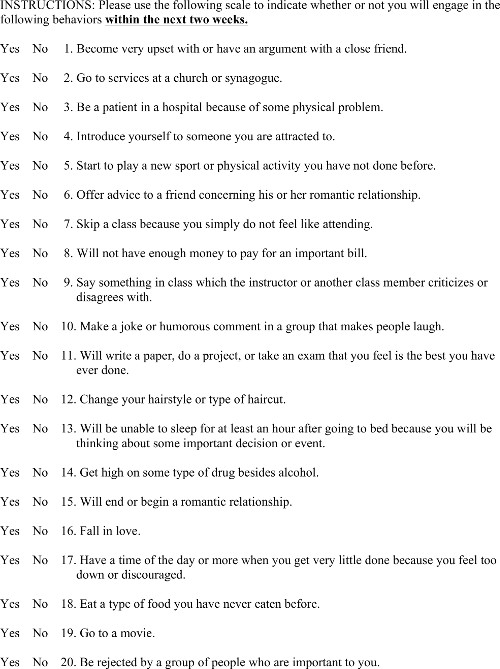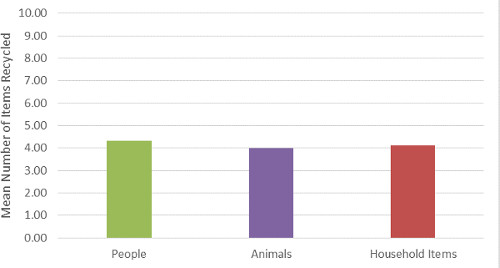Self-report vs. Behavioral Measures of Recycling
Overview
Source: Laboratories of Gary Lewandowski, Dave Strohmetz, and Natalie Ciarocco—Monmouth University
One of the challenges in measuring an experimental variable is identifying the technique that will produce the more accurate measurement. The most common way to measure a dependent variable is self-report—asking the participant to describe his/her feelings, thoughts, or behaviors. Yet, people may not be honest. To truly know something about a participant, it may be necessary to see what they actually do in a situation.
This video uses a multi-group experiment to see if feeling close to others results in more favorable attitudes toward environmental consciousness measured both by self-report and behavioral observation.
Psychological studies often use higher sample sizes than studies in other sciences. A large number of participants helps to better ensure that the population under study is better represented, i.e., the margin of error accompanied by studying human behavior is sufficiently accounted for. In this video, we demonstrate this experiment using just one participant. However, as represented in the results, we used a total of 186 participants to reach the experiment’s conclusions.
Procedure
1. Define key variables.
- Create an operational definition (i.e., a clear description of exactly what a researcher means by a concept) of feeling close to people.
- For the purposes of this experiment, feeling close to people involves a perceived connection including feelings of emotional attachment toward another person or people.
- Create an operational definition (i.e., a clear description of exactly what a researcher means by a concept) of environmental consciousness.
- For purposes of this experiment, environmental consciousness is defined as a person’s likelihood to value practices that protect the natural world.
2. Conduct the study.
- Meet the participant in a laboratory/classroom.
- Provide participant with informed consent, a brief description of the research (getting students’ opinions on various social issues), a sense of the procedure, an indication of potential risks/benefits, the right of withdrawal at any time, and a manner to get help if they experience discomfort.
- Participant signs informed consent form.
- Direct participant by saying: “For the next part of the study, I’d like you to sit and look at several pictures. Indicate on each of the index cards how close or connected you feel to the image, where 1 = not at all and 10 = extremely.”
- Manipulation (3 conditions): participant is directed to view slides of one of the three following sets of pictures.
- Feeling-Close-to-People condition: 5 pictures of people together
- Feeling-Close-to-Animals condition: 5 pictures of animals together
- Control/No connection condition: 5 pictures of everyday, non-living items
- Give participant 2 surveys (Appendices 1 and 2) and say: “Please take a minute to consider each question and indicate how you feel about each.”

Appendix 1. Survey 1 given to participants. This survey was used to measure attitudes towards recycling.

Appendix 2. Survey 2 given to participants. This survey served as a distractor.- Note that one is the real survey and one is a filler/distractor.
- While the participant completes the survey, pretend to each lunch out of the participant’s sight.
- The meal should have a range of recyclable and non-recyclable items (Recyclable= glass/plastic bottle, paper plate, paper napkin, plastic spoon, and plastic pudding/yogurt container; Non-recyclable= pretzels, grapes, and apple). Also on the table where the meal is eaten is a crumbled up piece of paper and a broken pen.
- When the participant finishes the surveys, ask the participant to help clear off the table where lunch was eaten so he or she can do the next part of the study.
- The room should have two clearly labeled empty bins, one for trash and one for recycling.
- While the participant clears off the table, the researcher should appear busy looking for/preparing the next part of the study.
3. Debrief.
- “Thank you for participating. In this study I was trying to determine if feeling a close connection to other people would influence your environmental consciousness, measured by your recycling attitudes (measured via the survey) and behaviors (measured via how many items you recycled when clearing off the table). There were three groups in the study, one group saw pictures of people together, another group saw pictures of animals, and the other group saw pictures of common items. We hypothesized that those in the feeling-close-to-other-people condition would have more favorable attitudes toward recycling and would recycle more.”
- “We couldn’t tell you about the study’s true purpose or our hypotheses ahead of time because we wanted to get your honest and natural thoughts and reactions. Because of the nature of the deception, it is quite natural for participants to not realize that they were being deceived.”
4. Go through the “Conducting the Study” procedure three times with three different participants: once for the people condition, once for the animal condition, and once for the household items condition.
5. Data Analysis
- Look at the participant’s survey and circle items 3, 5, and 7.
- Explain that these three items comprise the participant’s mean recycling attitude score, while the other items are simply distractors.
- Look in the bins to count the number of properly recycled items. This is the participant’s behavior score.
- Calculate the means by hand.
Results
This procedure was repeated 185 times so that the results reflect data from 186 total participants. This large number of participants helps to ensure that the results reflect accurate mean numbers of items recycled. If this research were conducted using just one or two participants, it is likely that the results would have been much different, and not reflective of the greater population. Numbers in Figure 1 reflect participants’ average responses for the recycling questions on the survey. Numbers in Figure 2 represent the number of items (out of 10 total) the participant properly put in the recycling bin.
To determine if there were differences between the three picture conditions, an analysis of variance (ANOVA) was performed. The results indicated that though there were significant differences for the self-report survey, such that those in the feeling-close-to-people condition said they cared about recycling more, there were no significant differences when it came to participants’ actual behavior.

Figure 1. Average recycling attitude score by condition. Means were calculated from survey questions 3, 5, and 7.

Figure 2. Average number of properly recycled items by condition. Means were calculated from researcher’s observations of items placed in the recycling bin.
Application and Summary
This multi-group experiment shows how participants’ feelings measured via a survey may not match up exactly with how they behave. In this case, participants reported more favorable attitudes (especially in the feeling-close-to-people condition), but when it came time to actually recycle, participants did not engage in the behavior.
This study replicates and extends previous research on self-reported recycling attitudes vs. actual recycling by Huffman et al., which showed that actual recycling was not associated with recycling attitudes and weakly correlated with self-reported recycling (i.e., did they recycle in the past).1
Several papers have emphasized the importance of behavioral measures, including Baumeister et al. and Lewandowski and Strohmetz.2,3 In each case, the key take away was that what a person actually does is more revealing than what the same person claims they will do. Though more challenging, measuring behavior is more informative.
Skip to...
Videos from this collection:

Now Playing
Self-report vs. Behavioral Measures of Recycling
Experimental Psychology
11.8K Views

From Theory to Design: The Role of Creativity in Designing Experiments
Experimental Psychology
18.8K Views

Ethics in Psychology Research
Experimental Psychology
29.3K Views

Realism in Experimentation
Experimental Psychology
8.3K Views

Perspectives on Experimental Psychology
Experimental Psychology
5.7K Views

Pilot Testing
Experimental Psychology
10.3K Views

Observational Research
Experimental Psychology
13.2K Views

The Simple Experiment: Two-group Design
Experimental Psychology
74.8K Views

The Multi-group Experiment
Experimental Psychology
22.9K Views

Within-subjects Repeated-measures Design
Experimental Psychology
23.1K Views

The Factorial Experiment
Experimental Psychology
73.3K Views

Reliability in Psychology Experiments
Experimental Psychology
8.6K Views

Placebos in Research
Experimental Psychology
11.6K Views

Manipulating an Independent Variable through Embodiment
Experimental Psychology
8.5K Views

Experimentation using a Confederate
Experimental Psychology
17.8K Views
Copyright © 2025 MyJoVE Corporation. All rights reserved